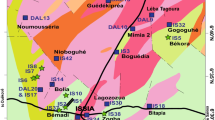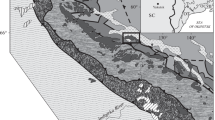Abstract
In the Lachlan Fold Belt of southeastern Australia, Upper Devonian A-type granite suites were emplaced after the Lower Devonian I-type granites of the Bega Batholith. Individual plutons of two A-type suites are homogeneous and the granites are characterized by late interstitial annite. Chemically they are distinguished from I-type granites with similar SiO2 contents of the Bega Batholith, by higher abundances of large highly charged cations such as Nb, Ga, Y, and the REE and lower Al, Mg and Ca: high Ga/Al is diagnostic. These A-type suites are metaluminous, but peralkaline and peraluminous A-type granites also occur in Australia and elsewhere.
Partial melting of felsic granulite is the preferred genetic model. This source rock is the residue remaining in the lower crust after production of a previous granite. High temperature, vapour-absent melting of the granulitic source generates a low viscosity, relatively anhydrous melt containing F and possibly Cl. The framework structure of this melt is considerably distorted by the presence of these dissolved halides allowing the large highly charged cations to form stable high co-ordination structures. The high concentration of Zr and probably other elements such as the REE in peralkaline or near peralkaline A-type melts is a result of the counter ion effect where excess alkali cations stabilize structures in the melt such as alkali-zircono-silicates. The melt structure determines the trace element composition of the granite.
Separation of a fluid phase from an A-type magma results in destabilization of co-ordination complexes and in the formation of rare-metal deposits commonly associated with fluorite. At this stage the role of Cl in metal transport is considered more important than F.
Similar content being viewed by others
References
Aylett BJ (1973) Group IIB. In: Trotman-Dickenson AF. (ed) Comprehensive inorganic chemistry, Vol. 3. Pergamon Press, Oxford, pp 187–328
Barker F, Wones DR, Sharp WN, Desborough GA (1975) The Pikes Peak Batholith, Colorado Front Range, and a model for the origin of the Gabbro-Anorthosite-Syenite-Potassic Granite suite. Prec Res 2:97–160
Barth TFW (1945) Studies of the igneous rock complex of the Oslo Region II. Systematic petrography of the plutonic rocks. Skr Nor Vidsk-Akad, Oslo 1. Mat Naturv Kl, pp 1–104
Beams SD (1980) Magmatic evolution of the southeast Lachlan Fold Belt, Australia. PhD Thesis La Trobe Univ (Unpubl)
Beams SD, Chappell BW, White AJR (1982) Anatomy of a Palaeozoic Batholith (in prep.)
Bonin B, Grelou-Orsini C, Vialette Y (1978) Age, origin and evolution of the anorogenic complex of Evisa (Corsica): a K-Li-Rb-Sr study. Contrib Mineral Petrol 65:425–432
Bowden P (1966) Zirconium in younger granites of northern Nigeria. Geochim Cosmochim Acta 30:985–993
Bowden P, Whitley JE (1974) Rare-earth patterns in peralkaline and associated granites. Lithos 7:15–21
Bowen NL (1945) Phase equilibria bearing on the origin and differentiation of alkaline trends. Am J Sci 243-A:75–89
Brown C, Fyfe WS (1970) The production of granite melts during ultrametamorphism. Contrib Mineral Petrol 28:310–318
Burnham CW (1979) Magmas and hydrothermal fluids. In: Barnes HL (ed) Geochemistry of hydrothermal ore deposits. John Wiley & Sons, NY pp 71–136
Burns RG (1970) Mineralogical applications of crystal field theory. Cambridge University Press, p 224
Buma G, Frey FA, Wones DR (1971) New England granites: trace element evidence regarding their origin and differentiation. Contrib Mineral Petrol 31:300–320
Chappell BW, White AJR (1974) Two contrasting granite types. Pacific Geology 8:173–174
Chayes F (1963) Relative abundance of intermediate members of the oceanic basalt-trachyte association. J Geophys Res 68:1819–1534
Chou I, Eugster HP (1977) Solubility of magnetite in supercritical chloride solutions. Am J Sci 277:1296–1314
Compston W, Chappell BW (1979) Strontium isotopic evolution of granitoid source rocks. In: McElhinney MW (ed) The Earth. Academic Press, London, pp 377–424
Collins WJ (1977) Geology and geochemistry of the Gabo Island Granite Suite and associated rocks. B Sc (Hons). Aust Nat Univ (Unpubl)
Cotton FA, Wilkinson G (1980) Advanced inorganic chemistry. New York, John Wiley Interscience
Dietrich RV, Heier KS, Taylor SR (1965) Studies on the igneous rock complex of the Oslo Region. XX. Petrology and geochemistry of ekerite. Skr Nor Vidsk-Akad, Oslo 1. Mat-Naturv Kl Ny Serie 19:1–31
Eadington PJ, Giblin A (1979) Alteration minerals and the precipitation of tin in granitic rocks. CSIRO Technical Communication Report 68, Institute of Earth Resources
Fergusson CL, Cas RA, Collins WJ, Craig GY, Crook KAW, Powell CMcA, Scott PA, Young GC (1979) The Upper Devonian Boyd Volcanic Complex, Eden, New South Wales. J Geol Soc Aust 26:87–105
Fergusson J (1974) Stereochemistry and bonding in inorganic chemistry. Prentice-Hall, NJ p 309
Gerasimovsky VI, Volkov VP, Kogarko LN, Polyakov AI (1974) Kola Peninsula. In: Sørenson H (ed) The alkaline rocks. J Wiley and Sons, London, pp 206–220
Goodman RJ (1972) The distribution of Ga and Rb in coexisting groundmass and phenocryst phases of some basic volcanic rocks. Geochim Cosmochim Acta 36:303–317
Griffin TJ, White AJR, Chappell BW (1978) The Moruya Batholith and geochemical contrasts between the Moruya and Jindabyne Suites. J Geol Soc Aust 25:235–247
Gunow AJ, Ludington S, Munoz JL (1980) Fluorine in micas from the Henderson molydenite deposit, Colorado. Econ Geol 75:1127–1137
Hine R, Williams IS, Chappell BW, White AJR (1978) Contrasts between I- and S-type granitoids of the Kosciusko Batholith J Geol Soc Aust 25:219–234
Holland HD (1972) Granites, solutions and base metal deposits. Econ Geol 67:281–301
Holloway JR, Ford CE (1975) Fluid-absent melting of the fluorohydroxy amphibole pargasite to 35 kilobars. Earth Planet Sci Lett 25:44–49
Imeokparia EG (1982) Geochemistry and relationships to mineralization of granitic rocks from the Afu Younger Granite Complex, Central Nigeria. Geol Mag 119:39–56
Kilinc IA, Burnham CW (1972) Partitioning of chloride between a silicate melt and coexisting aqueous phase from 2 to 8 kilobars. Econ Geol 67:231–235
Kwak TAP, Asking PW (1981) The nomenclature of carbonate replacement deposits, with emphasis on Sn-F(-Be-Zn) ‘wrigglite’ skarns. J Geol Soc Aust 28:123–136
Lamarre AL, Hodder RW (1978) Distribution and genesis of fluorite deposits in the western United States and their significance to metallogeny. Geology 6:236–238
Lipman PW, Prostka HJ, Christiansen RL (1972) Cenozoic volcanism and plate-tectonic evolution of the western United States, Part I: Early and middle Cenozoic. Philos Trans R Soc London 271-A:217–248
Loiselle MC, Wones DR (1979) Characteristics and origin of anorgenic granites. Geol Soc Am Abstr with Progr 11:468
Manning DAC, Hamilton DL, Henderson CMB, Dempsey MJ (1980) The probable occurrence of interstitial Al in hydrous, F-bearing and F-free aluminosilicate melts. Contrib Mineral Petrol 75:257–262
McCarthy TS, Hasty RA (1976) Trace element distribution patterns and their relationship to the crystallization of granitic melts. Geochim Cosmochim Acta 40:1351–1358
McIlveen GR (1975) The Eden-Comerong-Yalwal Rift Zone and contained gold mineralization. Rec Geol Surv NSW 16:245–277
Moeller T (1972) Complexes of the Lanthanides. In: Emdens HJ, Braynall KW (eds) MTP International Review of Science Inorganic Chemistry, Vol. 7. Butterworth Univ Press London, pp 275–298
Munoz JL, Ludington SD (1974) Fluoride-hydroxyl exchange in biotite. Am J Sci 274:396–413
Nesbitt HW (1980) Genesis of the New Quebec and Adirondack granulites: evidence for their production by partial melting. Contrib Mineral Petrol 72:303–310
Neumann ER, Brunfelt AP, Finstad KG (1977) Rare earth elements in some igneous rocks in the Oslo rift, Norway. Lithos 10:311–319
Richardson CK, Holland HD (1979) The solubility of fluorite in hydrothermal solutions; an experimental study. Geochim Cosmochim Acta 43:1313–1325
Sawkins FJ, Scherkenbach DA (1981) High copper content of fluid inclusions in quartz from northern Sonora: implications for oregenesis theory. Geology 9:37–40
Shaw HR, Smith RL, Hildreth W (1976) Thermogravitational mechanisms for chemical variations in zoned magma chambers. Geol Soc Am Abstr with Progr 8:1102
Streckeisen AL (1973) Plutonic rocks: classification and nomenclature recommended by the IUGS Subcommission of the systematics of igneous rocks. Geotimes 18:26–30
Tuttle OF, Bowen NL (1958) Origin of granite in the light of experimental studies in the system NaAlSi3O8-KAlSi3O8-SiO2-H2O. Geol Soc Am Mem 74:153
Upton BGJ (1974) The alkaline province of South-West Greenland. In: Sørenson H (ed) The alkaline rocks. J Wiley & Sons, London pp 221–237
van Breemen O, Hutchinson J, Bowden P (1975) Age and origin of the Nigerian Mesozoic granites: a Rb-Sr isotopic study. Contrib Mineral Petrol 50:157–172
Velde B, Kushiro I (1978) Structure of sodium alumino-silicate melts quenced at high pressure; infrared and aluminium K-radiation data. Earth Planet Sci Lett 40:137–140
Watson EB (1979) Zircon saturation in felsic liquids: experimental results and applications to trace element geochemistry. Contrib Mineral Petrol 70:407–419
White AJR, Chappell BW (1977) Ultrametamorphism and granitoid genesis. Tectonophysics 43:7–22
White AJR, Chappell BW (1982) Granitoid types and their distribution in southeast Australia. In: Roddick J (ed) Circumpacific plutonism. Geol Soc Am Mem (in press)
Wyllie PJ, Tuttle OF (1964) Experimental investigations of silicate systems containing two volatile components. Part III. The effects of SO3, P2O5, HCl and Li2O, in addition to H2O on the melting temperatures of albite and granite. Am J Sci 262:930–939
Author information
Authors and Affiliations
Rights and permissions
About this article
Cite this article
Collins, W.J., Beams, S.D., White, A.J.R. et al. Nature and origin of A-type granites with particular reference to southeastern Australia. Contr. Mineral. and Petrol. 80, 189–200 (1982). https://doi.org/10.1007/BF00374895
Received:
Accepted:
Issue Date:
DOI: https://doi.org/10.1007/BF00374895




